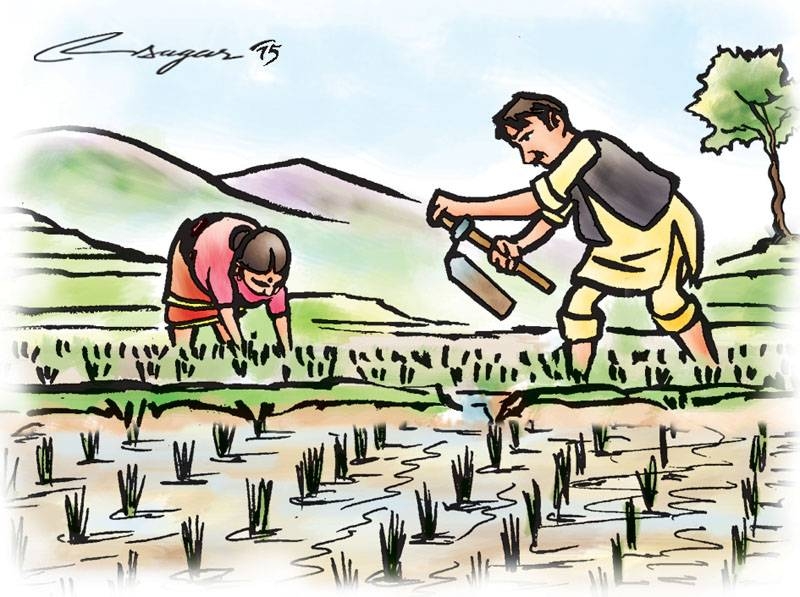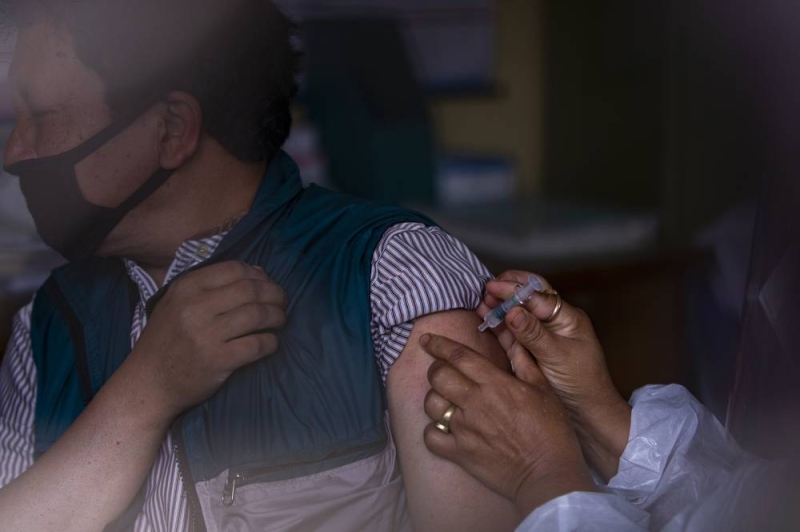Where has all the music gone?
With the COVID-19 pandemic having silenced the bhajan mandals of Kathmandu Valley, Bhaktapur denizens say their City exudes an air of mourning and silence
Published: 11:35 am Aug 08, 2021

KATHMANDU, JULY 7
On his daily morning walks, Bhaktapur resident Samir Disti used to come across elderly people singing bhajans (religious devotional songs) and playing traditional musical instruments in the Taumadi Square - in the paati (traditional places used for resting and performing religious, and cultural activities) in front of the Bhairabnath Temple of Bhaktapur - before the pandemic.
However, the singing of bhajans in most places of Bhaktapur has stopped with the onset of the COVID-19 pandemic in the country last year, and Disti feels that this lends an air that says the City is silent and mourning.
And though he didn't understand what the bhajans meant, he used to experience pleasant vibes as he passed the musical ambience in the Square.
Now that the bhajans have stopped - with the imposition of lockdown last year and this year's prohibitory orders - 'I miss the performances of bhajans by groups of people in the stretch from Dattatreya Square to Siddhapokhari, mostly,' he expressed.
In the case of Bhaktapur, the bhajans used to be performed in paatis, usually near the temples by groups of devotees, mostly elderly, every morning and evening.
Halted by the pandemic According to Govinda Maan Shrestha, President of Kala Sanskriti Bhajan Mahaguthi Sansthan of Bhaktapur, the bhajan performance has been stopped in Taumadi Square and other places of Bhaktapur to minimise the risk of the spread of COVID-19 infection amongst the members of the bhajan khala/ guthi (traditional groups performing bhajans in Newari culture) and devotees visiting the temples.
Before the pandemic restrictions, different types of bhajans used to be performed in different occasions - Dafa Bhajan, Dhalcha Bhajan, Raas Bhajan, and Phalcha Bhajan - on different occasions in the paatis, an important part of the Newari culture.
The Phalcha Bhajan performance - done mostly in the mornings and evenings in public places around the temples of Kathmandu Valley - has been affected the most by the COVID-19 pandemic, as per Shrestha.
This is because, unlike the other three forms of bhajan, this requires more than two guthi members for the singing, Shrestha informed.
So, how hard has the pandemic hit the tradition of bhajan performances in Bhaktapur? According to Shrestha, there are more than 60 bhajan guthis (cultural groups performing bhajans) in Bhaktapur, but due to the pandemic less than 30 per cent of them have been continuing with their performances.
Few such guthis of Bhaktapur - Barahi Bhajan, Shyam Krishna Raas Bhajan, Bhajan Khala of Inacho Tole among others - have been performing bhajans daily at present.
Yet the performers are not without fear - the performances are done amidst the risk and fear of infection, and with utmost faith, said Shrestha.
As such the performances do not tend to be hours-long like in the past.
The bhajan khalas sing just the Pancha Bhajan at present, as per Shrestha.
Song in the name of Ganesha is performed in the beginning, followed by three songs of deities and temples where the bhajans are performed, concluding with the Aarati Bhajan, informed Shrestha. In pre-pandemic times, there would be more songs and elaborate performances.
The Barahi Bhajan Guthi of Bhaktapur is one of those performing the Panch Bhajan only at present. Member Govinda Karmacharya informed that despite their Guthi having prepared more than 10 bhajans in praise of Goddess Barahi, performances of all songs every day is not possible if one is to shorten the time of singing of the bhajans. His Guthi had even stopped performing bhajans in August last.
For this month of Shrawan, they have added one more bhajan to their performance every Saturday evening on the occasion of Chaturmas Mela.
In the past they used to have a feast while performing the bhajans of Chaturmas Mela, but they are not resuming that activity this time due to the fear of infection.
Even the number of members of the Guthi taking part in the bhajan is less - 'there are around 30 members in our bhajan khala, but their presence is less as compared to the past', as informed by Karmacharya.
And there are some bhajan guthis that have been performing short bhajans inside the temples, Shrestha added. That's because the disciplines, rules, systems, and responsibilities of different bhajan khalas have been interrupted by the pandemic, he said.
Take for instance the ritual of the Guthi Sansthan of Bhaktapur - it used to honour the best bhajan khala for performing bhajan in a systematic way, every year. Now it unable to nominate the winner as there has been inconsistency in bhajan performances by the bhajan khalas, due to the pandemic, Shrestha informed Culture expert Purusottam Lochan Shrestha said that almost all the main temples, not only of Bhaktapur but of the entire Kathmandu Valley, have been left without the music of bhajan due to the pandemic.
He said, 'Phalcha Bhajan which engages more than three people in the bhajan mandal (group of bhajan performers) at paatis is certain to be affected by the pandemic as there is a gathering of many people at once. But Dhalcha Bhajan, which can be performed in small groups of two or three people, is also rarely performed now.'
However, Karmacharya does not feel there is much risk of COVID-19 infection while they perform Phalcha Bhajan. He reasoned that only 20 to 30 guthi members take part in the bhajan performances and that is safe.
'We have been telling members not to come for the performances, if they are unable to do so or fear the risk of infection. Yet we have been requesting our members to follow all safety protocols like wearing masks, and using sanitisers. Some people are stubborn and refuse to wear masks - in such cases we sit maintaining distance with them, thus ensuring we are safe,' he claimed.
Home without family
Disti feels that the temples and paatis nearby have become bereft like homes without family members in the absence of regular bhajan performances.
In traditional bhajan performances in the Newari community, devotees and members of the community's group or guthi gather in phalcha (paati) around the temple and sing bhajans with full devotion every morning and evening, and on different religious and cultural celebrations.
Even those who visit the temples and are not the members of the community or the bhajan guthi tend to listen to the bhajan performances.
Elaborating on the belief associated with the bhajan performances, Karmacharya explained, 'People say that even if Yamaraj (the god of death) comes to Earth to take a human life, he is unable to take away the lives of those devotees who are listening to the bhajans at such paatis.'
He reminisced that there used to be a crowd of listeners and guthi members around paatis to listen to and perform bhajans. And there was a unique pleasant feeling to witness the ambience, which had given life to the Bhaktapur City, as per Disti.
He wished, 'As it is impossible and inappropriate to do any jatras and other festivals amidst the pandemic, I think bhajan performances could be one of the safest ways to revive the liveliness of the City present. I think it is safe too as bhajan performances don't need many people to perform and they don't need to interact with other people.'
According to Purusottam Lochan, bhajan has been in practice since ancient times. In the case of the Newari community of the Kathmandu Valley, it was practised especially since the Malla dynasty.
'There is no particular traditional belief that something will go wrong if bhajan culture is paused, but there are guthis which take responsibility to continue, preserve or end the tradition of performing bhajan,' he explained.
Govinda Maan added that the Dafa Bhajans are mainly sung during big celebrations or occasions such as Dashain, month of Shrawan, Janai Purnima among others.
Lochan added, 'Not all bhajans are about religious devotion. Dhalcha Bhajan, and Phalcha Bhajan are sung to mark the completion of construction of public heritages like paati, temple, taps et cetera. Such bhajans include historical memos about the construction of temples, how they were constructed, among others. For instance, some bhajans performed in Taumadi are about the construction and history of the temple Nyatapola.
And not performing bhajans means missing out on these valuable cultural information too.'
A version of this article appears in the print on August 8 2021, of The Himalayan Times.



